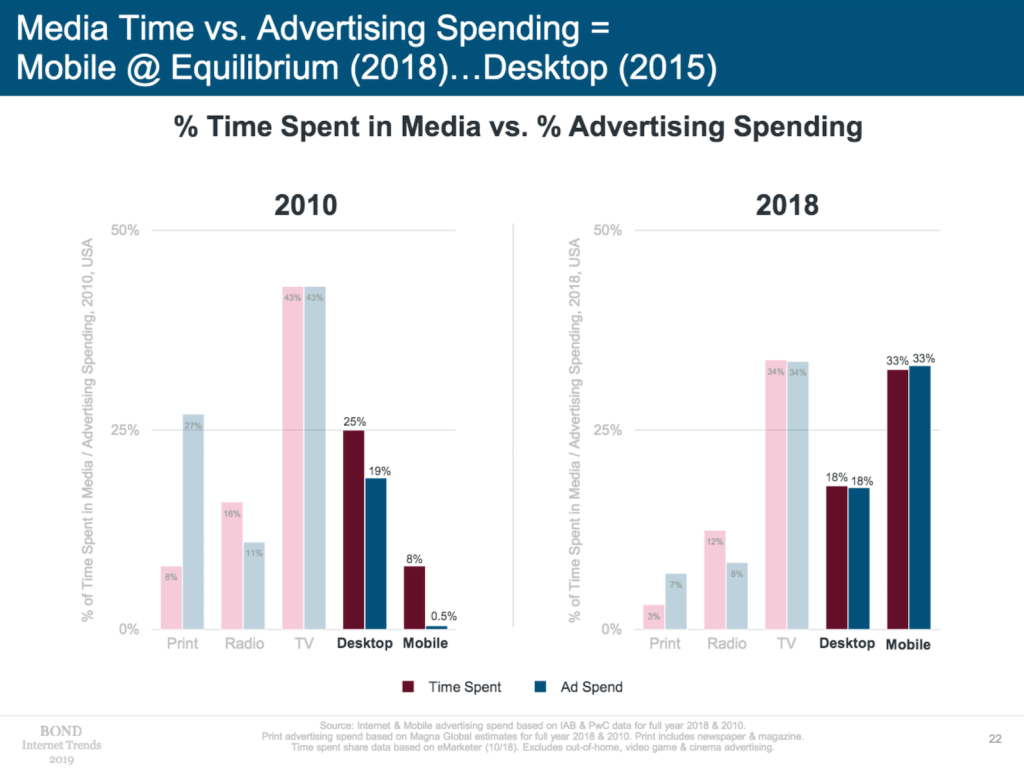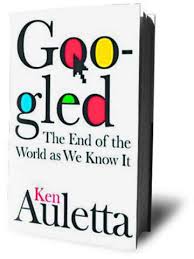Those that know me, know I don’t use profanity. But former radio CEO Mel Karmazin, upon learning about Google’s automated advertising sales algorithm, verbalized what every nervous media and technology CEO was thinking when he said to Sergi Brin, Larry Page and Eric Schmidt “You’re fucking with the magic.” I read this in Ken Auletta’s 2009 book titled “Googled: The End of the World as We Know It.”
Media Advertising – The Last 10 Years
If we measure media advertising as a percentage of GDP (Gross Domestic Product), we see that in the last decade, media advertising in the United States was down 25% according to the Progressive Policy Institute. This think tank is reported to do some of the best research that uncouples advertising expenditures from the rest of the economy.
What caused this drop? Low cost digital ads, as compared to advertising rates in traditional media, what many of us used to call trading traditional media dollars for digital dimes.
Unfortunately, as traditional media, especially print, was seeing its advertiser base disappear, it compensated for fewer advertisers by raising its prices. Television did this too. They were assuming they held an impregnable position with advertisers. Unfortunately, they completely ignored the digital reality exploding all around them.
Radio’s Expansion
Similarly, the radio industry went about over-populating the AM and FM broadcast bands without acknowledging the growth of digital alternatives. The FCC’s “MM Docket 80-90” added over 700 new FM radio stations in the first three years after the law took effect in 1987. Then LPFM (Low Power FM radio signals) were added to help AM radio stations, as well as to provide local non-profit radio stations to communities that had no local radio service.
If that wasn’t enough, radio broadcasters began to embrace HD Radio (digital radio signals) when they learned that the same law that allowed for an AM radio station to rebroadcast its programming on an FM signal also allowed HD Radio broadcasts to be rebroadcast on an analog FM signal.
To be clear, in 1927 there were 705 commercial radio stations on-the-air (all on the AM band and most with transmitter power of under 1,000-watts). Today we have 25,819 radio stations (21,209 FM / 4,610 AM).
While all of this was going on at a frenetic pace, no one was paying attention to the 800-pound elephants in the room aka Facebook, Google, and Amazon.
Time Spent vs Ad Expenditures
It stands to reason, that the more time a person spends with a particular form of media, the more likely they are to be exposed to more of the advertising content it runs.
Ten years ago analyst Mary Meeker showed in her annual “State of the Internet” slide show, how things were trending negatively for traditional media.
For print, our media attention in 2010 was only 8%, but print commanded 27% of ad dollars. By 2018, our print attention had dropped to only 3%, and print’s ad dollars fell to 7%.
For TV, in 2010 it garnered 43% of our media attention, and commanded 43% of ad dollars. By 2018, both attention and ad dollars had fallen to 34%.
In 2010, for radio, we gave this medium 16% of our media attention and it collected 11% of the ad dollars. By 2018, our attention had fallen to 12% and radio’s ad dollars slipped to 8%.
Where did those ad dollars go? To digital media, as this Mary Meeker chart clearly shows.

More specifically, to mobile digital media.
In 2010, the smartphone in your pocket took up about 8% of our media attention and a paltry 0.5% of ad dollars spent. But by 2018, mobile digital media was commanding 33% of our attention and collecting an equal 33% of ad dollars, soon to be eclipsing TV in both metrics.
Too Little, Too Late
It’s easy to look back 20 years into the beginning of the 21st Century, and say what should have been done, but the fact of the matter remains that traditional media companies were in denial. The denial of the coming digital media world wasn’t just in the ad-supported mediums such as print, radio and TV, but also in companies like Kodak, which actually invented the digital camera in 1975, but whose leaders were in denial about it being the future of photography, and worried about cannibalizing its lucrative print film business.
Culture eats strategy for breakfast.
-Peter Drucker, legendary management consultant
Radio’s golden assets were its radio personalities and the relationships they built with the listeners. In the rush to expand, and appease shareholders who wanted accelerated growth, radio owners killed their “golden goose,” while enlarging its nest.
Radio continues to jettison the very people that connect its stations with their community of license.
Simon Sinek said, “People don’t buy what you do; they buy why you do it. And what you do, simply proves what you believe.”
For me, radio was a passion to make something great come out of a person’s radio speaker. It’s why I made radio broadcasting my career and why I went on to teach broadcasting at a university. It was my passion to create great radio!
What is radio’s WHY today?
I think that’s the question the industry needs to ask itself.
“If you keep your eye on the profit, you’re going to skimp on the product.
But if you focus on making really great products, then the profits will follow.”
-Steve Jobs

